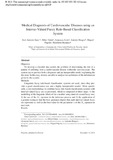Mostrar el registro sencillo del ítem
Medical diagnosis of cardiovascular diseases using an interval-valued fuzzy rule-based classification system
| dc.creator | Sanz Delgado, José Antonio | es_ES |
| dc.creator | Galar Idoate, Mikel | es_ES |
| dc.creator | Jurío Munárriz, Aránzazu | es_ES |
| dc.creator | Brugos Larumbe, Antonio | es_ES |
| dc.creator | Pagola Barrio, Miguel | es_ES |
| dc.creator | Bustince Sola, Humberto | es_ES |
| dc.date.accessioned | 2015-07-27T10:04:57Z | |
| dc.date.available | 2015-11-28T00:00:22Z | |
| dc.date.issued | 2013 | |
| dc.identifier.issn | 1568-4946 | |
| dc.identifier.uri | https://hdl.handle.net/2454/17688 | |
| dc.description.abstract | Objective: To develop a classifier that tackles the problem of determining the risk of a patient of suffering from a cardiovascular disease within the next ten years. The system has to provide both a diagnosis and an interpretable model explaining the decision. In this way, doctors are able to analyse the usefulness of the information given by the system. Methods: Linguistic fuzzy rule-based classification systems are used, since they provide a good classification rate and a highly interpretable model. More specifically, a new methodology to combine fuzzy rule-based classification systems with interval-valued fuzzy sets is proposed, which is composed of three steps: 1) the modelling of the linguistic labels of the classifier using interval-valued fuzzy sets; 2) the use of the Kα operator in the inference process and 3) the application of a genetic tuning to find the best ignorance degree that each interval-valued fuzzy set represents as well as the best value for the parameter α of the Kα operator in each rule. Results: The suitability of the new proposal to deal with this medical diagnosis classification problem is shown by comparing its performance with respect to the one provided by two classical fuzzy classifiers and a previous interval-valued fuzzy rule-based classification system. The performance of the new method is statistically better than the ones obtained with the methods considered in the comparison. The new proposal enhances both the total number of correctly diagnosed patients, around 3% with respect the classical fuzzy classifiers and around 1% versus the previous interval-valued fuzzy classifier, and the classifier ability to correctly differentiate patients of the different risk categories. Conclusion: The proposed methodology is a suitable tool to face the medical diagnosis of cardiovascular diseases, since it obtains a good classification rate and it also provides an interpretable model that can be easily understood by the doctors. | en |
| dc.description.sponsorship | This work was partially supported by the Spanish Ministry of Science and Technology under project TIN2010-15055 and the Research Services of the Universidad Pública de Navarra. | en |
| dc.format.mimetype | application/pdf | en |
| dc.language.iso | eng | en |
| dc.publisher | Elsevier | en |
| dc.relation.ispartof | Applied Soft Computing 20 (2014) 103–111 | en |
| dc.rights | © 2013 Elsevier B.V. The manuscript version is made available under the CC BY-NC-ND 4.0 license | en |
| dc.rights.uri | http://creativecommons.org/licenses/by-nc-nd/4.0/ | |
| dc.subject | Linguistic fuzzy rule-based classification systems | en |
| dc.subject | Interval-valued fuzzy sets | en |
| dc.subject | Genetic fuzzy systems | en |
| dc.subject | Cardiovascular diseases | en |
| dc.title | Medical diagnosis of cardiovascular diseases using an interval-valued fuzzy rule-based classification system | en |
| dc.type | Artículo / Artikulua | es |
| dc.type | info:eu-repo/semantics/article | en |
| dc.contributor.department | Automática y Computación | es_ES |
| dc.contributor.department | Automatika eta Konputazioa | eu |
| dc.contributor.department | Ciencias de la Salud | es_ES |
| dc.contributor.department | Osasun Zientziak | eu |
| dc.rights.accessRights | Acceso abierto / Sarbide irekia | es |
| dc.rights.accessRights | info:eu-repo/semantics/openAccess | en |
| dc.embargo.terms | 2015-11-28 | |
| dc.identifier.doi | 10.1016/j.asoc.2013.11.009 | |
| dc.relation.projectID | info:eu-repo/grantAgreement/MICINN//TIN2010-15055/ES/ | en |
| dc.relation.publisherversion | https://doi.org/10.1016/j.asoc.2013.11.009 | |
| dc.type.version | Versión aceptada / Onetsi den bertsioa | es |
| dc.type.version | info:eu-repo/semantics/acceptedVersion | en |
| dc.contributor.funder | Universidad Pública de Navarra / Nafarroako Unibertsitate Publikoa | es |



